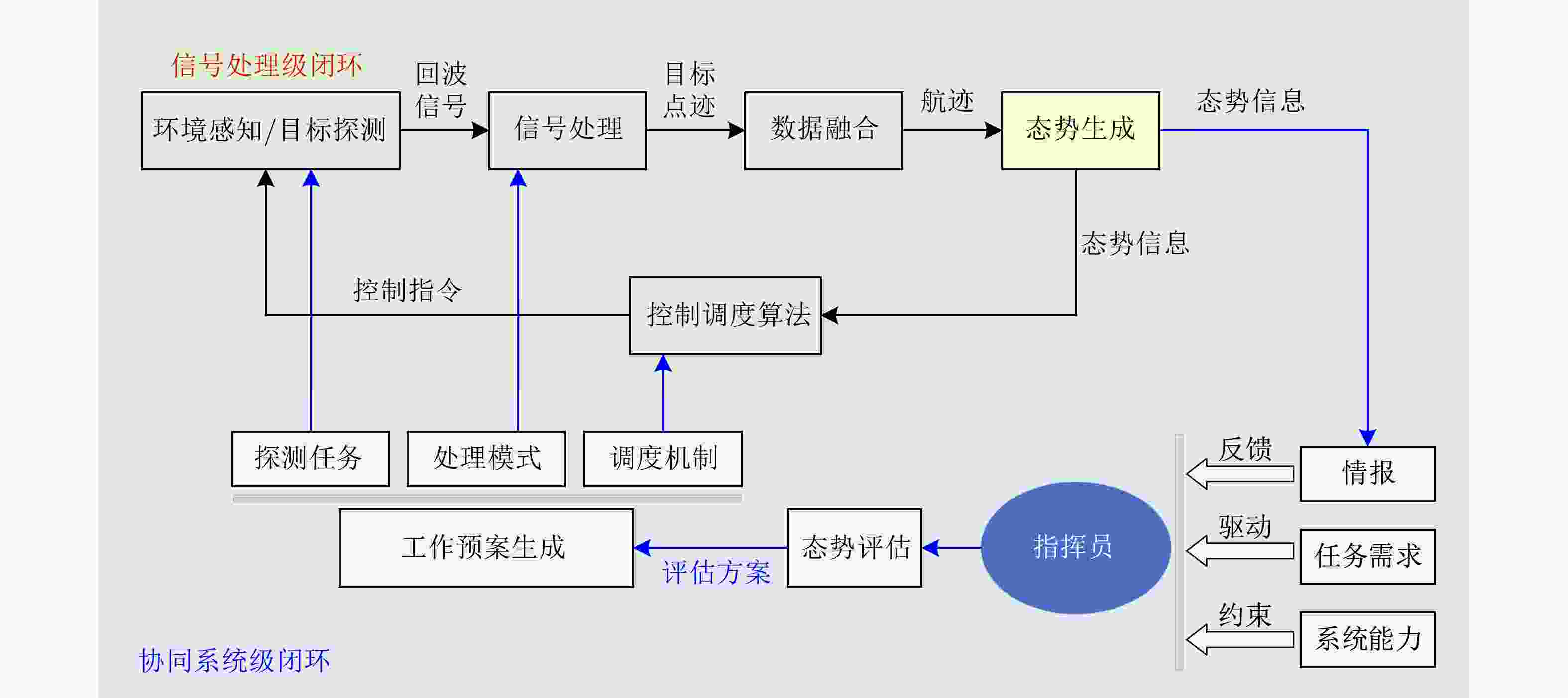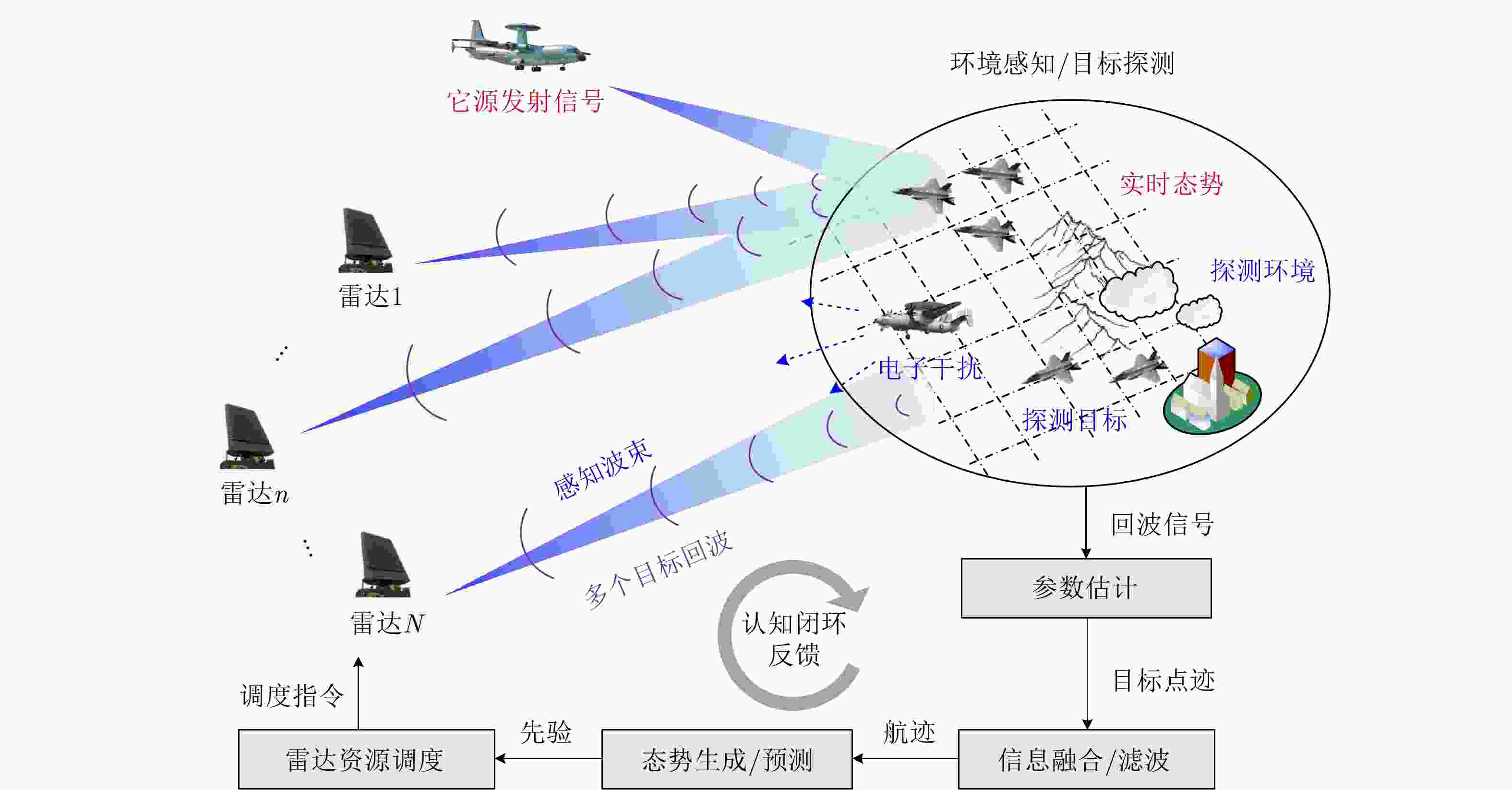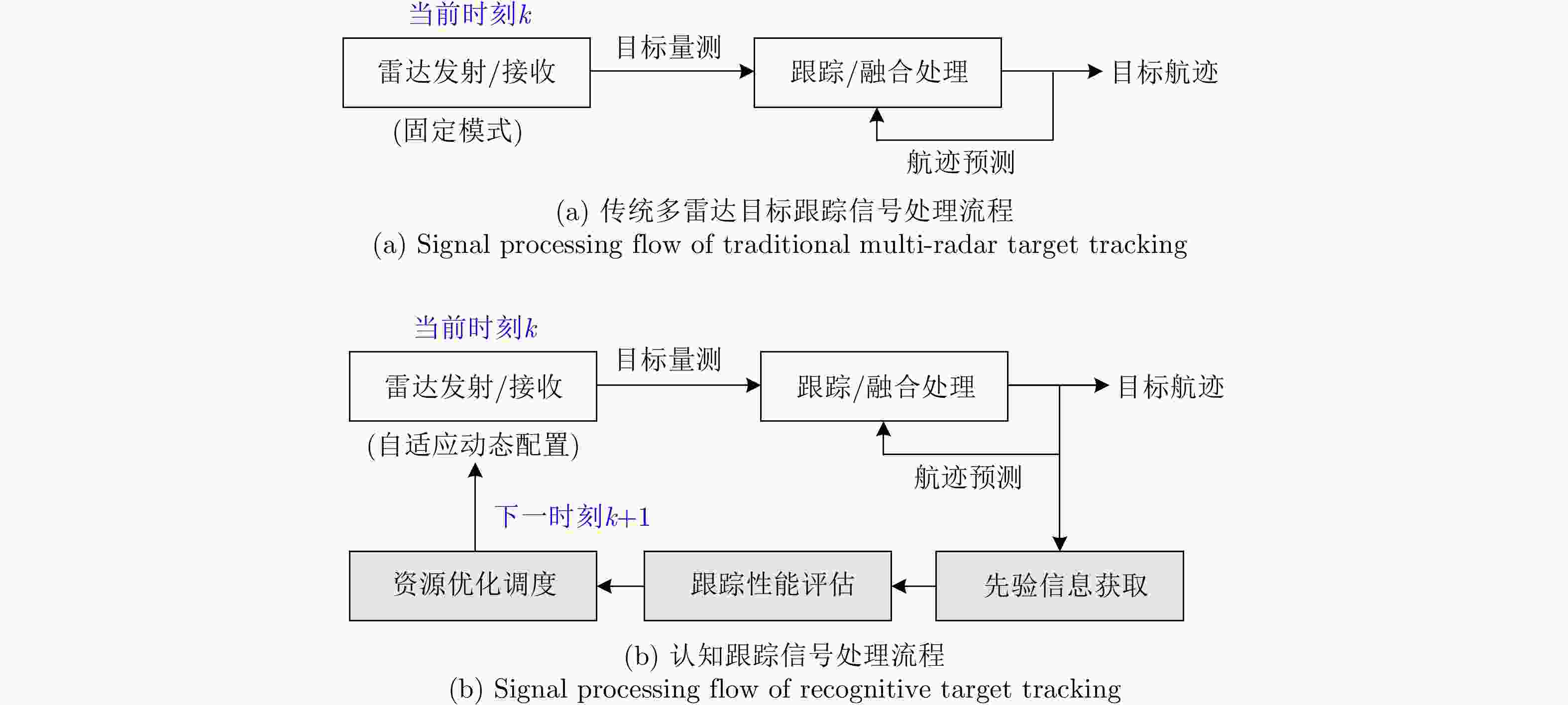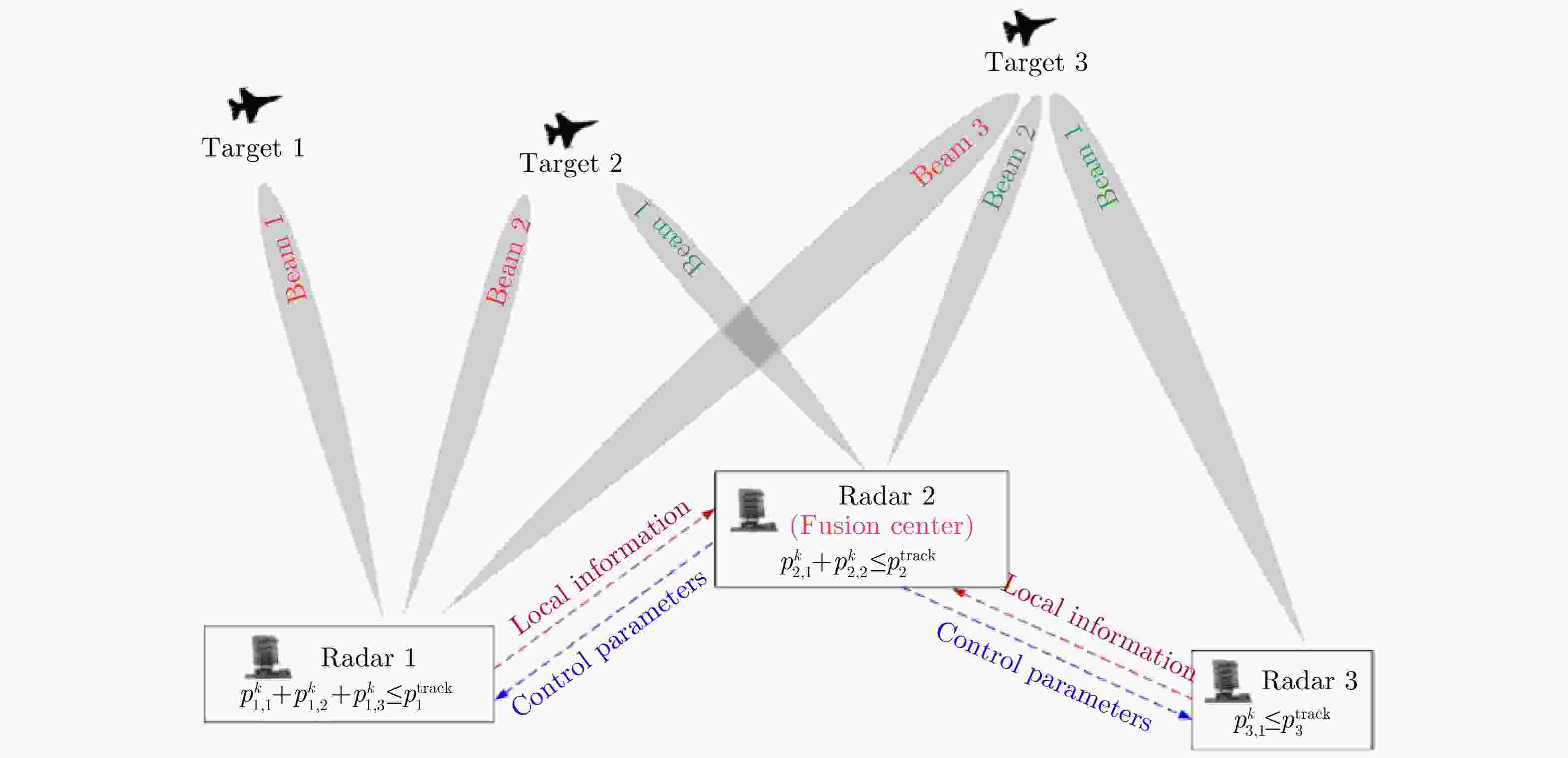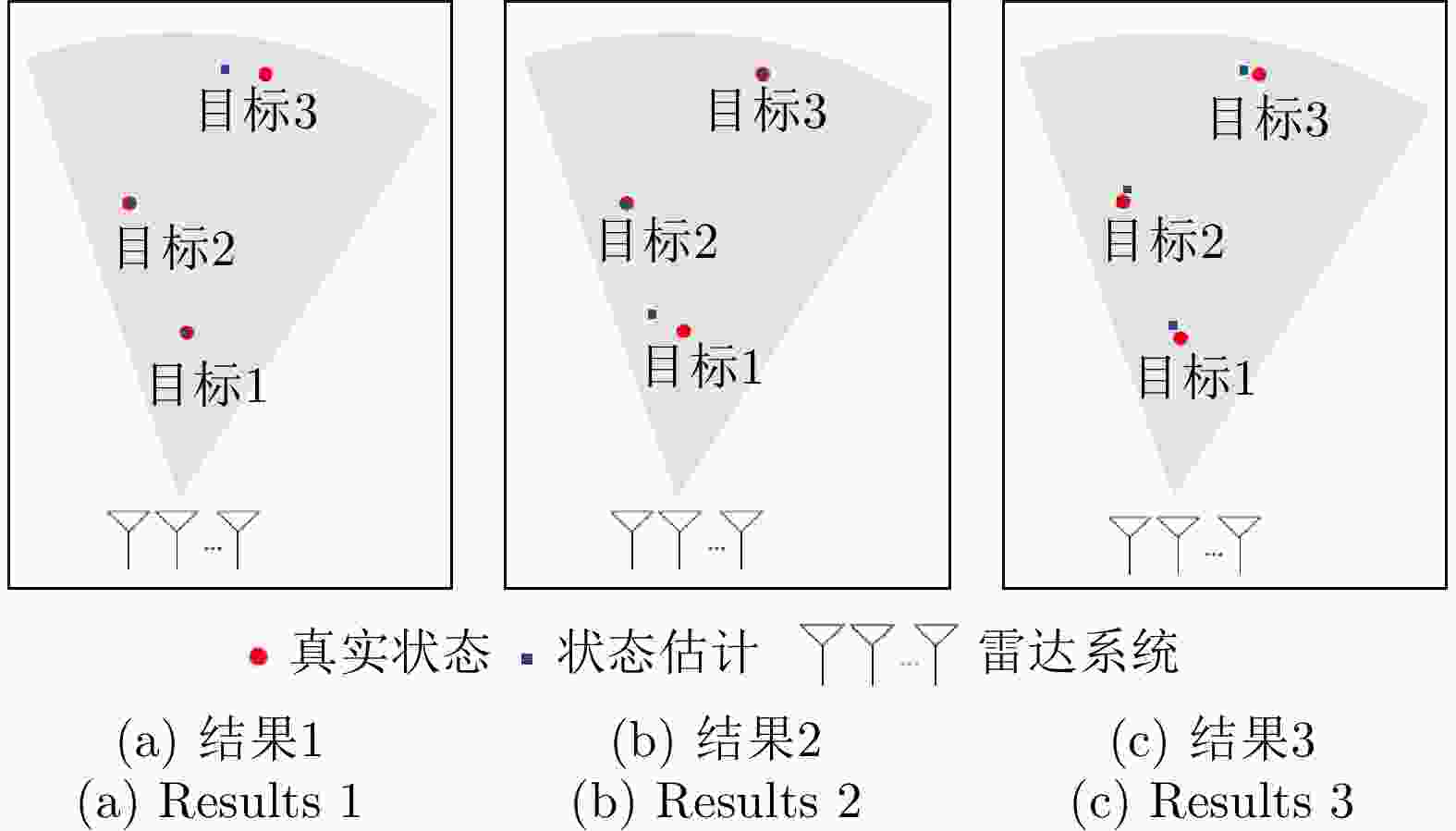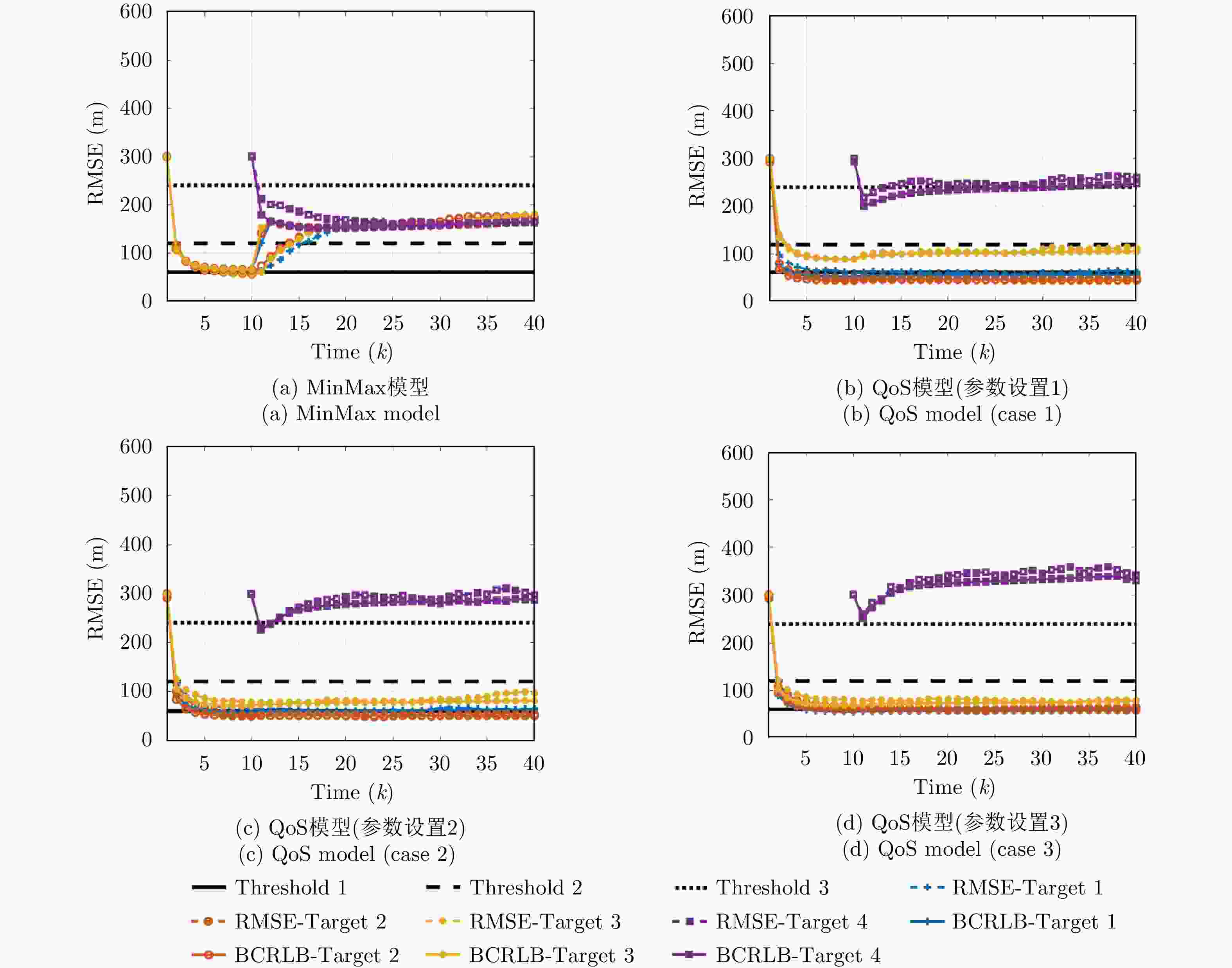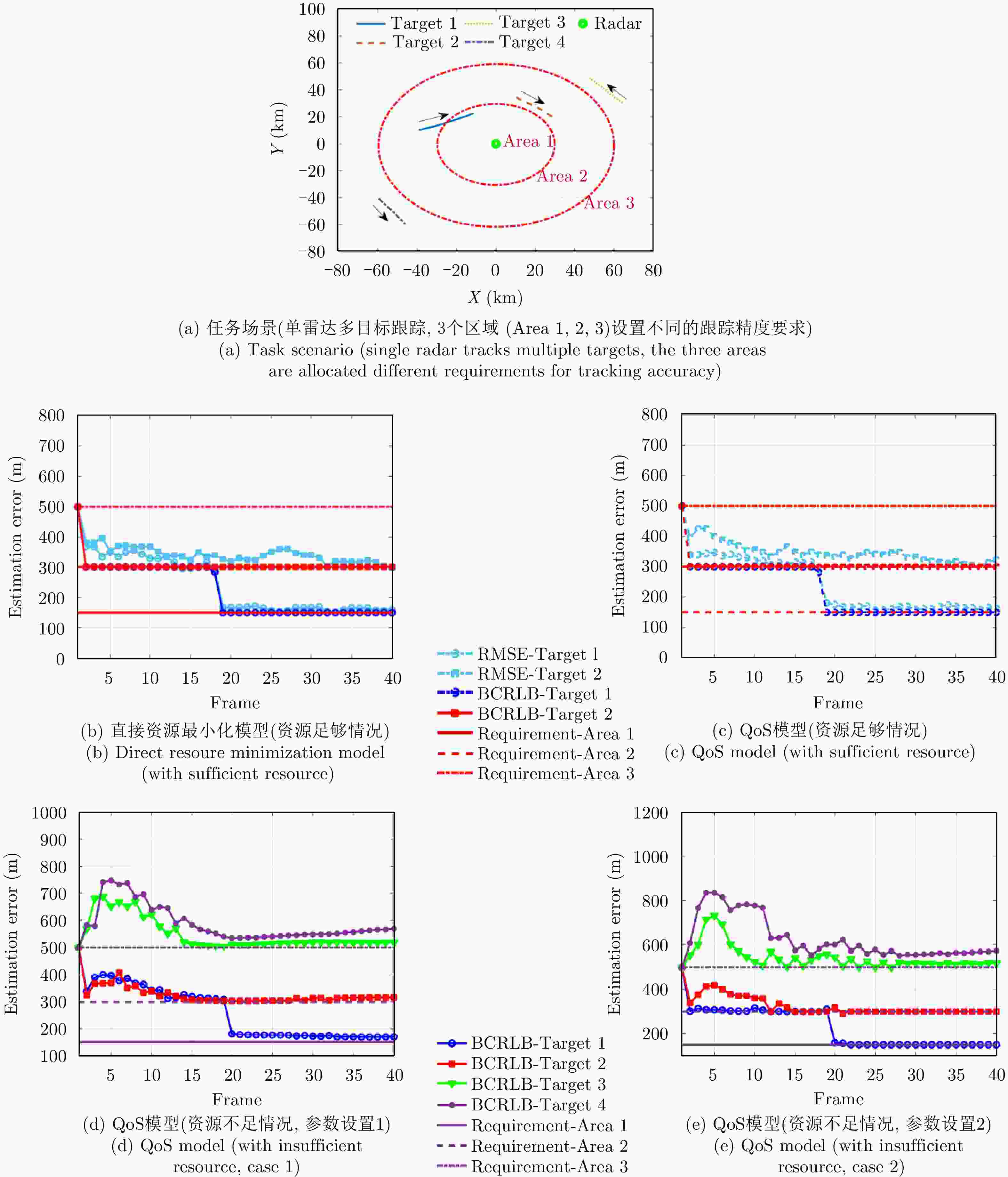| [1] |
丁建江. 预警装备组网协同探测模型及应用[J]. 现代雷达, 2020, 42(12): 13–18. doi: 10.16592/j.cnki.1004-7859.2020.12.003DING Jianjiang. Model and application of the synergy-netted detection for early warning equipment[J]. Modern Radar, 2020, 42(12): 13–18. doi: 10.16592/j.cnki.1004-7859.2020.12.003
|
| [2] |
董晓龙, 吴季, 姜景山. 微波辐射计用于隐身目标探测的性能分析[J]. 系统工程与电子技术, 2001, 23(3): 54–57. doi: 10.3321/j.issn:1001-506X.2001.03.016DONG Xiaolong, WU Ji, and JIANG Jingshan. The performance of the detection of stealthy targets by microwave radiometer[J]. Systems Engineering and Electronics, 2001, 23(3): 54–57. doi: 10.3321/j.issn:1001-506X.2001.03.016
|
| [3] |
DERHAM T, WOODBRIDGE K, GRIFFITHS H, et al. The design and development of an experimental netted radar system[C]. 2003 International Conference on Radar (IEEE Cat. No. 03EX695), Adelaide, Australia, 2003: 293–298.
|
| [4] |
BAKER C J and HUME A L. Netted radar sensing[J]. IEEE Aerospace and Electronic Systems Magazine, 2003, 18(2): 3–6. doi: 10.1109/MAES.2003.1183861
|
| [5] |
杨建宇. 雷达技术发展规律和宏观趋势分析[J]. 雷达学报, 2012, 1(1): 19–27. doi: 10.3724/SP.J.1300.2012.20010YANG Jianyu. Development laws and macro trends analysis of radar technology[J]. Journal of Radars, 2012, 1(1): 19–27. doi: 10.3724/SP.J.1300.2012.20010
|
| [6] |
周琳. 雷达组网协同探测系统技术架构设计[J]. 现代雷达, 2020, 42(12): 19–23. doi: 10.16592/j.cnki.1004-7859.2020.12.004ZHOU Lin. Technical architecture design of radar network cooperative detection system[J]. Modern Radar, 2020, 42(12): 19–23. doi: 10.16592/j.cnki.1004-7859.2020.12.004
|
| [7] |
王小军, 张修社, 胡小全, 等. 基于杀伤链感知的动态可重构作战体系结构[J]. 现代导航, 2020, 11(4): 235–243, 249. doi: 10.3969/j.issn.1674-7976.2020.04.001WANG Xiaojun, ZHANG Xiushe, HU Xiaoquan, et al. Dynamic reconfigurable combat architecture based on kill chain perception[J]. Modern Navigation, 2020, 11(4): 235–243, 249. doi: 10.3969/j.issn.1674-7976.2020.04.001
|
| [8] |
刘宏伟, 严峻坤, 周生华. 网络化雷达协同探测技术[J]. 现代雷达, 2020, 42(12): 7–12. doi: 10.16592/j.cnki.1004-7859.2020.12.002LIU Hongwei, YAN Junkun, and ZHOU Shenghua. Collaborative detection technology of netted radar[J]. Modern Radar, 2020, 42(12): 7–12. doi: 10.16592/j.cnki.1004-7859.2020.12.002
|
| [9] |
马林, 周琳. 预警系统协同探测技术研究[J]. 现代雷达, 2020, 42(12): 1–6. doi: 10.16592/j.cnki.1004-7859.2020.12.001MA Lin and ZHOU Lin. A study on collaborative detection technology of early warning system[J]. Modern Radar, 2020, 42(12): 1–6. doi: 10.16592/j.cnki.1004-7859.2020.12.001
|
| [10] |
葛建军, 李春霞. 探测体系能力生成理论及方法[J]. 雷达科学与技术, 2018, 16(3): 237–241, 248. doi: 10.3969/j.issn.1672-2337.2018.03.001GE Jianjun and LI Chunxia. Theory and method for capability generation of detection system[J]. Radar Science and Technology, 2018, 16(3): 237–241, 248. doi: 10.3969/j.issn.1672-2337.2018.03.001
|
| [11] |
丁建江. 组网协同探测闭环与预案的设计[J]. 雷达科学与技术, 2021, 19(1): 7–13. doi: 10.3969/j.issn.1672-2337.2021.01.002DING Jianjiang. Design of the closed-loop and pre-arranged planning for synergy-netted detection[J]. Radar Science and Technology, 2021, 19(1): 7–13. doi: 10.3969/j.issn.1672-2337.2021.01.002
|
| [12] |
DAVIS M S, SHOWMAN G A, and LANTERMAN A D. Coherent MIMO radar: The phased array and orthogonal waveforms[J]. IEEE Aerospace and Electronic Systems Magazine, 2014, 29(8): 76–91. doi: 10.1109/MAES.2014.130148
|
| [13] |
陈金立, 顾红, 苏卫民, 等. 基于发射分集的MIMO雷达相参信号处理方法[J]. 系统工程与电子技术, 2009, 31(8): 1836–1841. doi: 10.3321/j.issn:1001-506X.2009.08.013CHEN Jinli, GU Hong, SU Weimin, et al. Method of coherent signal processing for MIMO radar based on transmitting diversity[J]. Systems Engineering and Electronics, 2009, 31(8): 1836–1841. doi: 10.3321/j.issn:1001-506X.2009.08.013
|
| [14] |
鲁耀兵, 张履谦, 周荫清, 等. 分布式阵列相参合成雷达技术研究[J]. 系统工程与电子技术, 2013, 35(8): 1657–1662. doi: 10.3969/j.issn.1001-506X.2013.08.12LU Yaobing, ZHANG Lüqian, ZHOU Yinqing, et al. Study on distributed aperture coherence-synthetic radar technology[J]. Systems Engineering and Electronics, 2013, 35(8): 1657–1662. doi: 10.3969/j.issn.1001-506X.2013.08.12
|
| [15] |
米闯. 分布式阵列相参合成雷达的发射相参相关研究[D]. [硕士论文], 西安电子科技大学, 2014.MI Chuang. Study on transmit coherence of distributed aperture coherence-synthetic radar[D]. [Master dissertation], Xidian University, 2014.
|
| [16] |
HAIMOVICH A M, BLUM R S, and CIMINI L J. MIMO radar with widely separated antennas[J]. IEEE Signal Processing Magazine, 2008, 25(1): 116–129. doi: 10.1109/MSP.2008.4408448
|
| [17] |
FISHLER E, HAIMOVICH A, BLUM R S, et al. Spatial diversity in radars—models and detection performance[J]. IEEE Transactions on Signal Processing, 2006, 54(3): 823–838. doi: 10.1109/TSP.2005.862813
|
| [18] |
向龙, 丁建江, 周芬, 等. 协同探测群柔性架构分析与设计[J]. 现代雷达, 2022, 44(4): 1–5. doi: 10.16592/j.cnki.1004-7859.2022.04.001XIANG Long, DING Jianjiang, ZHOU Fen, et al. Analysis and design for the flexible architecture of synergy-netted detection cluster[J]. Modern Radar, 2022, 44(4): 1–5. doi: 10.16592/j.cnki.1004-7859.2022.04.001
|
| [19] |
HAYKIN S. Cognitive radar: A way of the future[J]. IEEE Signal Processing Magazine, 2006, 23(1): 30–40. doi: 10.1109/MSP.2006.1593335
|
| [20] |
CHARLISH A, HOFFMANN F, DEGEN C, et al. The development from adaptive to cognitive radar resource management[J]. IEEE Aerospace and Electronic Systems Magazine, 2020, 35(6): 8–19. doi: 10.1109/MAES.2019.2957847
|
| [21] |
BRYANT D J. Rethinking OODA: Toward a modern cognitive framework of command decision making[J]. Military Psychology, 2006, 18(3): 183–206. doi: 10.1207/s15327876mp1803_1
|
| [22] |
ARULAMPALAM M S, MASKELL S, GORDON N, et al. A tutorial on particle filters for online nonlinear/non-Gaussian Bayesian tracking[J]. IEEE Transactions on Signal Processing, 2002, 50(2): 174–188. doi: 10.1109/78.978374
|
| [23] |
YI Wei, YUAN Ye, HOSEINNEZHAD R, et al. Resource scheduling for distributed multi-target tracking in netted colocated MIMO radar systems[J]. IEEE Transactions on Signal Processing, 2020, 68: 1602–1617. doi: 10.1109/TSP.2020.2976587
|
| [24] |
LI X R and JILKOV V P. Survey of maneuvering target tracking. Part I. Dynamic models[J]. IEEE Transactions on Aerospace and Electronic Systems, 2003, 39(4): 1333–1364. doi: 10.1109/TAES.2003.1261132
|
| [25] |
YAN Junkun, JIAO Hao, PU Wenqiang, et al. Radar sensor network resource allocation for fused target tracking: A brief review[J]. Information Fusion, 2022, 86/87: 104–115. doi: 10.1016/j.inffus.2022.06.009
|
| [26] |
LIGGINS M E, CHONG C Y, KADAR I, et al. Distributed fusion architectures and algorithms for target tracking[J]. Proceedings of the IEEE, 1997, 85(1): 95–107. doi: 10.1109/JPROC.1997.554211
|
| [27] |
HAYKIN S, HUBER K, and CHEN Zhe. Bayesian sequential state estimation for MIMO wireless communications[J]. Proceedings of the IEEE, 2004, 92(3): 439–454. doi: 10.1109/JPROC.2003.823143
|
| [28] |
SÄRKKÄ S. Bayesian Filtering and Smoothing[M]. Cambridge: Cambridge University Press, 2013: 17–24.
|
| [29] |
LI Xueting, ZHANG Tianxian, YI Wei, et al. Radar selection based on the measurement information and the measurement compensation for target tracking in radar network[J]. IEEE Sensors Journal, 2019, 19(18): 7923–7935. doi: 10.1109/JSEN.2019.2918866
|
| [30] |
SHI Chenguang, ZHOU Jianjiang, and WANG Fei. Low probability of intercept optimization for radar network based on mutual information[C]. 2014 IEEE China Summit & International Conference on Signal and Information Processing (ChinaSIP), Xi’an, China, 2014: 683–687.
|
| [31] |
GODRICH H, HAIMOVICH A M, and BLUM R S. Target localization accuracy gain in MIMO radar-based systems[J]. IEEE Transactions on Information Theory, 2010, 56(6): 2783–2803. doi: 10.1109/TIT.2010.2046246
|
| [32] |
TICHAVSKY P, MURAVCHIK C H, and NEHORAI A. Posterior Cramer-Rao bounds for discrete-time nonlinear filtering[J]. IEEE Transactions on Signal Processing, 1998, 46(5): 1386–1396. doi: 10.1109/78.668800
|
| [33] |
YUAN Ye, YI Wei, HOSEINNEZHAD R, et al. Robust power allocation for resource-aware multi-target tracking with colocated MIMO radars[J]. IEEE Transactions on Signal Processing, 2021, 69: 443–458. doi: 10.1109/TSP.2020.3047519
|
| [34] |
YUAN Ye, YI Wei, and VARSHNEY P K. Exponential mixture density based approximation to posterior cramér-rao lower bound for distributed target tracking[J]. IEEE Transactions on Signal Processing, 2022, 70: 862–877. doi: 10.1109/TSP.2022.3148540
|
| [35] |
ZHANG Haowei, LIU Weijian, SHI Junpeng, et al. Joint detection threshold optimization and illumination time allocation strategy for cognitive tracking in a networked radar system[J]. IEEE Transactions on Signal Processing, 2022, 70: 5833–5847. doi: 10.1109/TSP.2022.3188205
|
| [36] |
王祥丽, 易伟, 孔令讲. 基于多目标跟踪的相控阵雷达波束和驻留时间联合分配方法[J]. 雷达学报, 2017, 6(6): 602–610. doi: 10.12000/JR17045WANG Xiangli, YI Wei, and KONG Lingjiang. Joint beam selection and dwell time allocation for multi-target tracking in phased array radar system[J]. Journal of Radars, 2017, 6(6): 602–610. doi: 10.12000/JR17045
|
| [37] |
YAN Junkun, PU Wenqiang, LIU Hongwei, et al. Cooperative target assignment and dwell allocation for multiple target tracking in phased array radar network[J]. Signal Processing, 2017, 141: 74–83. doi: 10.1016/j.sigpro.2017.05.014
|
| [38] |
YAN Junkun, PU Wenqiang, DAI Jinhui, et al. Resource allocation for search and track application in phased array radar based on Pareto bi-objective optimization[J]. IEEE Transactions on Vehicular Technology, 2019, 68(4): 3487–3499. doi: 10.1109/TVT.2019.2894960
|
| [39] |
SHI Chenguang, DING Lintao, WANG Fei, et al. Joint target assignment and resource optimization framework for multitarget tracking in phased array radar network[J]. IEEE Systems Journal, 2021, 15(3): 4379–4390. doi: 10.1109/JSYST.2020.3025867
|
| [40] |
YUAN Ye, YI Wei, and KONG Lingjiang. Joint tracking sequence and dwell time allocation for multi-target tracking with phased array radar[J]. Signal Processing, 2021, 192: 108374. doi: 10.1016/j.sigpro.2021.108374
|
| [41] |
KIRUBARAJAN T, BAR-SHALOM Y, BLAIR W D, et al. IMMPDA solution to benchmark for radar resource allocation and tracking in the presence of ECM[C]. 1997 European Control Conference (ECC), Brussels, Belgium, 1997: 2967–2972.
|
| [42] |
BLAIR W D and WATSON G A. Benchmark problem for radar resource allocation and tracking maneuvering targets in the presence of ECM[R]. Naval Surface Warfare Center Dahlgren Division, Dahlgren, VA, 1996.
|
| [43] |
MOO P W and DING Zhen. Coordinated radar resource management for networked phased array radars[J]. IET Radar, Sonar & Navigation, 2015, 9(8): 1009–1020. doi: 10.1049/iet-rsn.2013.0368
|
| [44] |
LI Jian and STOICA P. MIMO radar with colocated antennas[J]. IEEE Signal Processing Magazine, 2007, 24(5): 106–114. doi: 10.1109/MSP.2007.904812
|
| [45] |
YAN Junkun, LIU Hongwei, PU Wenqiang, et al. Joint beam selection and power allocation for multiple target tracking in netted colocated MIMO radar system[J]. IEEE Transactions on Signal Processing, 2016, 64(24): 6417–6427. doi: 10.1109/TSP.2016.2607147
|
| [46] |
YAN Junkun, LIU Hongwei, JIU Bo, et al. Simultaneous multibeam resource allocation scheme for multiple target tracking[J]. IEEE Transactions on Signal Processing, 2015, 63(12): 3110–3122. doi: 10.1109/TSP.2015.2417504
|
| [47] |
YAN Junkun, LIU Hongwei, JIU Bo, et al. Joint detection and tracking processing algorithm for target tracking in multiple radar system[J]. IEEE Sensors Journal, 2015, 15(11): 6534–6541. doi: 10.1109/JSEN.2015.2461435
|
| [48] |
CHENG Ting, LI Shuyi, and ZHANG Jie. Adaptive resource management in multiple targets tracking for co-located multiple input multiple output radar[J]. IET Radar, Sonar & Navigation, 2018, 12(9): 1038–1045. doi: 10.1049/iet-rsn.2018.5153
|
| [49] |
ZHANG Weiwei, SHI Chenguang, and ZHOU Jianjiang. Power minimization-based joint resource allocation algorithm for target localization in noncoherent distributed MIMO radar system[J]. IEEE Systems Journal, 2022, 16(2): 2183–2194. doi: 10.1109/JSYST.2021.3126152
|
| [50] |
SHI Chenguang, DING Lintao, WANG Fei, et al. Low probability of intercept-based collaborative power and bandwidth allocation strategy for multi-target tracking in distributed radar network system[J]. IEEE Sensors Journal, 2020, 20(12): 6367–6377. doi: 10.1109/JSEN.2020.2977328
|
| [51] |
REN Haiwei, YI Wei, LU Xiujuan, et al. Online beam scheduling for multi-target tracking in linear wireless array radar[C]. 2021 CIE International Conference on Radar (Radar), Haikou, China, 2021: 2553–2558.
|
| [52] |
SUN Hao, LI Ming, ZUO Lei, et al. Joint radar scheduling and beampattern design for multitarget tracking in netted colocated MIMO radar systems[J]. IEEE Signal Processing Letters, 2021, 28: 1863–1867. doi: 10.1109/LSP.2021.3108675
|
| [53] |
CHEN Haowen, TA Shiying, and SUN Bin. Cooperative game approach to power allocation for target tracking in distributed MIMO radar sensor networks[J]. IEEE Sensors Journal, 2015, 15(10): 5423–5432. doi: 10.1109/JSEN.2015.2431261
|
| [54] |
胡捍英, 孙扬, 郑娜娥. 多目标速度估计的分布式MIMO雷达资源分配算法[J]. 电子与信息学报, 2016, 38(10): 2453–2460. doi: 10.11999/JEIT151452HU Hanying, SUN Yang, and ZHENG Na’e. Resource allocation approach in distributed MIMO radar with multiple targets for velocity estimation[J]. Journal of Electronics &Information Technology, 2016, 38(10): 2453–2460. doi: 10.11999/JEIT151452
|
| [55] |
ZHANG Haowei, XIE Junwei, GE Jiaang, et al. Finite sensor selection algorithm in distributed MIMO radar for joint target tracking and detection[J]. Journal of Systems Engineering and Electronics, 2020, 31(2): 290–302. doi: 10.23919/JSEE.2020.000007
|
| [56] |
XIE Mingchi, YI Wei, KONG Lingjiang, et al. Receive-beam resource allocation for multiple target tracking with distributed MIMO radars[J]. IEEE Transactions on Aerospace and Electronic Systems, 2018, 54(5): 2421–2436. doi: 10.1109/TAES.2018.2818579
|
| [57] |
LIU Xinghua, XU Zhenhai, DONG Wei, et al. Cognitive resource allocation for target tracking in location-aware radar networks[J]. IEEE Signal Processing Letters, 2020, 27: 650–654. doi: 10.1109/LSP.2020.2987208
|
| [58] |
WANG Wenqin. Moving-target tracking by cognitive RF stealth radar using frequency diverse array antenna[J]. IEEE Transactions on Geoscience and Remote Sensing, 2016, 54(7): 3764–3773. doi: 10.1109/TGRS.2016.2527057
|
| [59] |
LIU Pengfei, LIU Yimin, HUANG Tianyao, et al. Decentralized automotive radar spectrum allocation to avoid mutual interference using reinforcement learning[J]. IEEE Transactions on Aerospace and Electronic Systems, 2021, 57(1): 190–205. doi: 10.1109/TAES.2020.3011869
|
| [60] |
DURST S and BRÜGGENWIRTH S. Quality of service based radar resource management using deep reinforcement learning[C]. 2021 IEEE Radar Conference (RadarConf21), Atlanta, USA, 2021: 1–6.
|
| [61] |
GARCIA N, HAIMOVICH A M, COULON M, et al. Resource allocation in MIMO radar with multiple targets for non-coherent localization[J]. IEEE Transactions on Signal Processing, 2014, 62(10): 2656–2666. doi: 10.1109/TSP.2014.2315169
|
| [62] |
CIUONZO D, JAVADI S H, MOHAMMADI A, et al. Bandwidth-constrained decentralized detection of an unknown vector signal via multisensor fusion[J]. IEEE Transactions on Signal and Information Processing over Networks, 2020, 6: 744–758. doi: 10.1109/TSIPN.2020.3037832
|
| [63] |
SELVI E, BUEHRER R M, MARTONE A, et al. Reinforcement learning for adaptable bandwidth tracking radars[J]. IEEE Transactions on Aerospace and Electronic Systems, 2020, 56(5): 3904–3921. doi: 10.1109/TAES.2020.2987443
|
| [64] |
SHI Chenguang, WANG Fei, SELLATHURAI M, et al. Power minimization-based robust OFDM radar waveform design for radar and communication systems in coexistence[J]. IEEE Transactions on Signal Processing, 2018, 66(5): 1316–1330. doi: 10.1109/TSP.2017.2770086
|
| [65] |
BELL K L, BAKER C J, SMITH G E, et al. Cognitive radar framework for target detection and tracking[J]. IEEE Journal of Selected Topics in Signal Processing, 2015, 9(8): 1427–1439. doi: 10.1109/JSTSP.2015.2465304
|
| [66] |
WANG Fangzhou and LI Hongbin. Joint power allocation for radar and communication co-existence[J]. IEEE Signal Processing Letters, 2019, 26(11): 1608–1612. doi: 10.1109/LSP.2019.2941087
|
| [67] |
SHI Chenguang, WANG Yijie, WANG Fei, et al. Joint optimization scheme for subcarrier selection and power allocation in multicarrier dual-function radar-communication system[J]. IEEE Systems Journal, 2021, 15(1): 947–958. doi: 10.1109/JSYST.2020.2984637
|
| [68] |
VAN CHIEN T, BJÖRNSON E, and LARSSON E G. Joint power allocation and load balancing optimization for energy-efficient cell-free massive MIMO networks[J]. IEEE Transactions on Wireless Communications, 2020, 19(10): 6798–6812. doi: 10.1109/TWC.2020.3006083
|
| [69] |
DING Lintao, SHI Chenguang, QIU Wei, et al. Joint dwell time and bandwidth optimization for multi-target tracking in radar network based on low probability of intercept[J]. Sensors, 2020, 20(5): 1269. doi: 10.3390/s20051269
|
| [70] |
LIU Xinghua, XU Zhenhai, WANG Luoshengbin, et al. Cognitive dwell time allocation for distributed radar sensor networks tracking via cone programming[J]. IEEE Sensors Journal, 2020, 20(10): 5092–5101. doi: 10.1109/JSEN.2020.2970280
|
| [71] |
MIR H S and GUITOUNI A. Variable dwell time task scheduling for multifunction radar[J]. IEEE Transactions on Automation Science and Engineering, 2014, 11(2): 463–472. doi: 10.1109/TASE.2013.2285014
|
| [72] |
WATSON G A and BLAIR W D. Tracking performance of a phased array radar with revisit time controlled using the IMM algorithm[C]. 1994 IEEE National Radar Conference, Atlanta, USA, 1994: 160–165.
|
| [73] |
SHI Yuchun, JIU Bo, YAN Junkun, et al. Data-driven radar selection and power allocation method for target tracking in multiple radar system[J]. IEEE Sensors Journal, 2021, 21(17): 19296–19306. doi: 10.1109/JSEN.2021.3087747
|
| [74] |
MOHAMMADI A and ASIF A. Decentralized sensor selection based on the distributed posterior Cramér-Rao lower bound[C]. 2012 15th International Conference on Information Fusion, Singapore, 2012: 1668–1675.
|
| [75] |
SHEN Xiaojing and VARSHNEY P K. Sensor selection based on generalized information gain for target tracking in large sensor networks[J]. IEEE Transactions on Signal Processing, 2014, 62(2): 363–375. doi: 10.1109/TSP.2013.2289881
|
| [76] |
ZOU Yi and CHAKRABARTY K. Sensor deployment and target localization in distributed sensor networks[J]. ACM Transactions on Embedded Computing Systems, 2004, 3(1): 61–91. doi: 10.1145/972627.972631
|
| [77] |
CHAVALI P and NEHORAI A. Scheduling and power allocation in a cognitive radar network for multiple-target tracking[J]. IEEE Transactions on Signal Processing, 2012, 60(2): 715–729. doi: 10.1109/TSP.2011.2174989
|
| [78] |
SUN Bin, CHEN Haowen, WEI Xizhang, et al. Power allocation for range-only localisation in distributed multiple-input multiple-output radar networks - a cooperative game approach[J]. IET Radar Sonar & Navigation, 2014, 8(7): 708–718.
|
| [79] |
YUAN Ye, YI Wei, KIRUBARAJAN T, et al. Scaled accuracy based power allocation for multi-target tracking with colocated MIMO radars[J]. Signal Processing, 2019, 158: 227–240. doi: 10.1016/j.sigpro.2019.01.014
|
| [80] |
XIE Mingchi, YI Wei, KIRUBARAJAN T, et al. Joint node selection and power allocation strategy for multitarget tracking in decentralized radar networks[J]. IEEE Transactions on Signal Processing, 2018, 66(3): 729–743. doi: 10.1109/TSP.2017.2777394
|
| [81] |
ZHANG Haowei, ZONG Binfeng, and XIE Junwei. Power and bandwidth allocation for multi-target tracking in collocated MIMO radar[J]. IEEE Transactions on Vehicular Technology, 2020, 69(9): 9795–9806. doi: 10.1109/TVT.2020.3002899
|
| [82] |
SU Yang, CHENG Ting, HE Zishu, et al. Adaptive resource management for multi-target tracking in co-located MIMO radar based on time-space joint allocation[J]. Journal of Systems Engineering and Electronics, 2020, 31(5): 916–927. doi: 10.23919/JSEE.2020.000061
|
| [83] |
ZHANG Haowei, LIU Weijian, XIE Junwei, et al. Joint subarray selection and power allocation for cognitive target tracking in large-scale MIMO radar networks[J]. IEEE Systems Journal, 2020, 14(2): 2569–2580. doi: 10.1109/JSYST.2019.2960401
|
| [84] |
MA Botao, CHEN Haowen, SUN Bin, et al. A joint scheme of antenna selection and power allocation for Localization in MIMO radar sensor networks[J]. IEEE communications letters, 2014, 18(12): 2225–2228. doi: 10.1109/LCOMM.2014.2365206
|
| [85] |
KATSILIERIS F, DRIESSEN H, and YAROVOY A. Threat-based sensor management for target tracking[J]. IEEE Transactions on Aerospace and Electronic Systems, 2015, 51(4): 2772–2785. doi: 10.1109/TAES.2015.140052
|
| [86] |
SHI Chenguang, WANG Yijie, SALOUS S, et al. Joint transmit resource management and waveform selection strategy for target tracking in distributed phased array radar network[J]. IEEE Transactions on Aerospace and Electronic Systems, 2021, 58(4): 2762–2778. doi: 10.1109/TAES.2021.3138869
|
| [87] |
JIN Biao, KUANG Xiaofei, LIU Shujin, et al. Joint allocation of transmit power and signal bandwidth for distributed cognitive tracking radar network using cooperative game[J]. Digital Signal Processing, 2023, 135: 103964. doi: 10.1016/j.dsp.2023.103964
|
| [88] |
孟令同, 易伟, 孔令讲. 动平台分布式雷达系统协同跟踪路径优化算法[J]. 信号处理, 2018, 34(11): 1321–1329. doi: 10.16798/j.issn.1003-0530.2018.11.007MENG Lingtong, YI Wei, and KONG Lingjiang. Path optimization method of distributed radar system with moving platform for cooperative target tracking[J]. Journal of Signal Processing, 2018, 34(11): 1321–1329. doi: 10.16798/j.issn.1003-0530.2018.11.007
|
| [89] |
TANG Yaoying, WANG Yao, and SHAO Xuehui. Mobile sensor path planning for multi-region surveillance with different mission importances[C]. 2019 International Conference on Control, Automation and Information Sciences (ICCAIS), Chengdu, China, 2019: 1–5.
|
| [90] |
LU Xiujuan, KONG Lingjiang, SUN Jun, et al. Joint online route planning and power allocation for multitarget tracking in airborne radar systems[C]. 2020 IEEE Radar Conference (RadarConf20), Florence, Italy, 2020: 1–6.
|
| [91] |
严俊坤, 白舸, 黄佳沁, 等. 多机雷达协同区域动态覆盖航迹优化方法[J]. 雷达学报, 2023, 12(3): 541–549. doi: 10.12000/JR22196YAN Junkun, BAI Ge, HUANG Jiaqin, et al. Flight path optimization method for dynamic area coverage based on multi-aircraft Radars[J]. Journal of Radars, 2023, 12(3): 541–549. doi: 10.12000/JR22196
|
| [92] |
DAI Jinhui, PU Wenqiang, YAN Junkun, et al. Multi-UAV collaborative trajectory optimization for asynchronous 3-D passive multitarget tracking[J]. IEEE Transactions on Geoscience and Remote Sensing, 2023, 61: 5101116. doi: 10.1109/TGRS.2023.3239952
|
| [93] |
DING Lintao, SHI Chenguang, and ZHOU Jianjiang. Collaborative route optimization and resource management strategy for multi-target tracking in airborne radar system[J]. Digital Signal Processing, 2023, 138: 104051. doi: 10.1016/j.dsp.2023.104051
|
| [94] |
YAN Junkun, HE Tao, MA Lin, et al. Maneuvering resource allocation for coordinated target tracking in airborne radar network[J]. IEEE Transactions on Signal Processing, 2023, 71: 1563–1573. doi: 10.1109/TSP.2023.3265882
|
| [95] |
YI Jianxin, WAN Xianrong, LEUNG H, et al. Joint placement of transmitters and receivers for distributed MIMO radars[J]. IEEE Transactions on Aerospace and Electronic Systems, 2017, 53(1): 122–134. doi: 10.1109/TAES.2017.2649338
|
| [96] |
LIANG Junli, HUAN Mingsai, DENG Xiaobo, et al. Optimal transmitter and receiver placement for localizing 2D interested-region target with constrained sensor regions[J]. Signal Processing, 2021, 183: 108032. doi: 10.1016/j.sigpro.2021.108032
|
| [97] |
WANG Yao, ZHOU Tao, and YI Wei. Geometric optimization of distributed MIMO radar system for accurate localization in multiple key subareas[J]. Signal Processing, 2022, 201: 108689. doi: 10.1016/j.sigpro.2022.108689
|
| [98] |
QI Cheng, XIE Junwei, and ZHANG Haowei. Joint antenna placement and power allocation for target detection in a distributed MIMO radar network[J]. Remote Sensing, 2022, 14(11): 2650. doi: 10.3390/rs14112650
|
| [99] |
YANG Chengxin, WANG Yao, and YI Wei. Network architecture optimization for area surveillance in multi-static radar systems[C]. 2020 IEEE Radar Conference (RadarConf20), Florence, Italy, 2020: 1–6.
|
| [100] |
HERNANDEZ M L, KIRUBARAJAN T, and BAR-SHALOM Y. Multisensor resource deployment using posterior Cramer-Rao bounds[J]. IEEE Transactions on Aerospace and Electronic Systems, 2004, 40(2): 399–416. doi: 10.1109/TAES.2004.1309993
|
| [101] |
THARMARASA R, KIRUBARAJAN T, and HERNANDEZ M. Large-scale optimal sensor array management for multitarget tracking[J]. IEEE Transactions on Systems, Man, and Cybernetics, Part C (Applications and Reviews), 2007, 37(5): 803–814. doi: 10.1109/TSMCC.2007.901003
|
| [102] |
YAN Junkun, LIU Hongwei, PU Wenqiang, et al. Joint threshold adjustment and power allocation for cognitive target tracking in asynchronous radar network[J]. IEEE Transactions on Signal Processing, 2017, 65(12): 3094–3106. doi: 10.1109/TSP.2017.2679693
|
| [103] |
YAN Junkun, PU Wenqiang, ZHOU Shenghua, et al. Optimal resource allocation for asynchronous multiple targets tracking in heterogeneous radar networks[J]. IEEE Transactions on Signal Processing, 2020, 68: 4055–4068. doi: 10.1109/TSP.2020.3007313
|
| [104] |
WU Linlong, MISHRA K V, SHANKAR M R B, et al. Resource allocation in heterogeneously-distributed joint radar-communications under asynchronous Bayesian tracking framework[J]. IEEE Journal on Selected Areas in Communications, 2022, 40(7): 2026–2042. doi: 10.1109/JSAC.2022.3157371
|
| [105] |
MOHAMMADI A and ASIF A. Decentralized conditional posterior Cramér-Rao lower bound for nonlinear distributed estimation[J]. IEEE Signal Processing Letters, 2013, 20(2): 165–168. doi: 10.1109/LSP.2012.2235430
|
| [106] |
CHEN Junting, DAI Wenhan, SHEN Yuan, et al. Resource management games for distributed network localization[J]. IEEE Journal on Selected Areas in Communications, 2017, 35(2): 317–329. doi: 10.1109/JSAC.2017.2659318
|
| [107] |
LU Yanxi, HE Zishu, CHENG Ziyang, et al. Adaptive resource allocation in decentralized colocated MIMO radar network for multiple targets tracking[C]. 2018 IEEE Radar Conference (RadarConf18), Oklahoma City, USA, 2018: 152–157.
|
| [108] |
JIANG Xinyue, YI Wei, YUAN Ye, et al. Network cost based node selection strategy for multiple target tracking in netted radar system[C]. 2019 IEEE Radar Conference (RadarConf), Boston, USA, 2019: 1–6.
|
| [109] |
DELIGIANNIS A, PANOUI A, LAMBOTHARAN S, et al. Game-theoretic power allocation and the nash equilibrium analysis for a multistatic MIMO radar network[J]. IEEE Transactions on Signal Processing, 2017, 65(24): 6397–6408. doi: 10.1109/TSP.2017.2755591
|
| [110] |
OZDEMIR O, NIU Ruixin, and VARSHNEY P K. Tracking in wireless sensor networks using particle filtering: Physical layer considerations[J]. IEEE Transactions on Signal Processing, 2009, 57(5): 1987–1999. doi: 10.1109/TSP.2009.2014818
|
| [111] |
YUAN Ye, YI Wei, CHOI W, et al. Dynamic quantizer design for target tracking for wireless sensor network with imperfect channels[J]. IEEE Transactions on Wireless Communications, 2023, 22(3): 1695–1711. doi: 10.1109/TWC.2022.3206493
|
| [112] |
高晓光, 李飞, 万开方. 数据丢包环境下的多传感器协同跟踪策略研究[J]. 系统工程与电子技术, 2018, 40(11): 2450–2458. doi: 10.3969/j.issn.1001-506X.2018.11.10GAO Xiaoguang, LI Fei, and WAN Kaifang. Research on multi-sensor cooperative tracking strategy in data packet loss environment[J]. Systems Engineering and Electronics, 2018, 40(11): 2450–2458. doi: 10.3969/j.issn.1001-506X.2018.11.10
|
| [113] |
ZUO Lei, HU Juan, SUN Hao, et al. Resource allocation for target tracking in multiple radar architectures over lossy networks[J]. Signal Processing, 2023, 208: 108973. doi: 10.1016/j.sigpro.2023.108973
|
| [114] |
HURTADO M, ZHAO Tong, and NEHORAI A. Adaptive polarized waveform design for target tracking based on sequential Bayesian inference[J]. IEEE Transactions on Signal Processing, 2008, 56(3): 1120–1133. doi: 10.1109/TSP.2007.909044
|
| [115] |
HUE C, LE CADRE J P, and PEREZ P. Posterior Cramer-Rao bounds for multi-target tracking[J]. IEEE Transactions on Aerospace and Electronic Systems, 2006, 42(1): 37–49. doi: 10.1109/TAES.2006.1603404
|
| [116] |
YAN Junkun, JIU Bo, LIU Hongwei, et al. Prior knowledge-based simultaneous multibeam power allocation algorithm for cognitive multiple targets tracking in clutter[J]. IEEE Transactions on Signal Processing, 2015, 63(2): 512–527. doi: 10.1109/TSP.2014.2371774
|
| [117] |
GROSSI E, LOPS M, and VENTURINO L. Joint design of surveillance radar and MIMO communication in cluttered environments[J]. IEEE Transactions on Signal Processing, 2020, 68: 1544–1557. doi: 10.1109/TSP.2020.2974708
|
| [118] |
FARINA A, RISTIC B, and TIMMONERI L. Cramer-Rao bound for nonlinear filtering with Pd<1 and its application to target tracking[J]. IEEE Transactions on Signal Processing, 2002, 50(8): 1916–1924. doi: 10.1109/TSP.2002.800411
|
| [119] |
ZUO Long, NIU Ruixin, and VARSHNEY P K. Conditional posterior Cramér-Rao lower bounds for nonlinear sequential Bayesian estimation[J]. IEEE Transactions on Signal Processing, 2011, 59(1): 1–14. doi: 10.1109/TSP.2010.2080268
|
| [120] |
ZHENG Yujiao, OZDEMIR O, NIU Ruixin, et al. New conditional posterior Cramér-Rao lower bounds for nonlinear sequential Bayesian estimation[J]. IEEE Transactions on Signal Processing, 2012, 60(10): 5549–5556. doi: 10.1109/TSP.2012.2205686
|
| [121] |
SUN Jun, YI Wei, VARSHNEY P K, et al. Resource scheduling for multi-target tracking in multi-radar systems with imperfect detection[J]. IEEE Transactions on Signal Processing, 2022, 70: 3878–3893. doi: 10.1109/TSP.2022.3191800
|
| [122] |
SUN Jun, YUAN Ye, WANG Yao, et al. Enumeration PCRLB-based power allocation for multitarget tracking with colocated MIMO radar systems in clutter[J]. IEEE Transactions on Geoscience and Remote Sensing, 2023, 61: 1–18. doi: 10.1109/TGRS.2023.3278727
|
| [123] |
MOHAMMADI A and ASIF A. Distributed posterior Cramér-Rao lower bound for nonlinear sequential Bayesian estimation[C]. 2012 IEEE 7th Sensor Array and Multichannel Signal Processing Workshop (SAM), Hoboken, USA, 2012: 509–512.
|
| [124] |
SUN Wei, YI Wei, XIE Mingchi, et al. Adaptive node and power simultaneous scheduling strategy for target tracking in distributed multiple radar systems[C]. 2017 20th International Conference on Information Fusion (Fusion), Xi’an, China, 2017: 1–6.
|
| [125] |
WANG Xiangli, YI Wei, XIE Mingchi, et al. Time management for target tracking based on the predicted Bayesian Cramer-Rao lower bound in phase array radar system[C]. 2017 20th International Conference on Information Fusion (Fusion), Xi’an, China, 2017: 1–5.
|
| [126] |
袁野. 面向认知跟踪的无线分布式雷达资源闭环调度方法研究[D]. [博士论文], 电子科技大学, 2022.YUAN Ye. Research on closed-form resource allocation for wireless distributed radars with cognitive tracking[D]. [Ph. D. dissertation], University of Electronic Science and Technology of China, 2022.
|
| [127] |
SCHUHMACHER D, VO B T, and VO B N. A consistent metric for performance evaluation of multi-object filters[J]. IEEE Transactions on Signal Processing, 2008, 56(8): 3447–3457. doi: 10.1109/TSP.2008.920469
|
| [128] |
IRCI A, SARANLI A, and BAYKAL B. Study on Q-RAM and feasible directions based methods for resource management in phased array radar systems[J]. IEEE Transactions on Aerospace and Electronic Systems, 2010, 46(4): 1848–1864. doi: 10.1109/TAES.2010.5595599
|
| [129] |
CHARLISH A and HOFFMANN F. Cognitive Radar Management[M]. KLEMM R. Novel Radar Techniques and Applications Volume 2: Waveform Diversity and Cognitive Radar. Oxford, U.K.: IET, 2017: 157–193.
|
| [130] |
GODRICH H, PETROPULU A P, and POOR H V. Power allocation strategies for target localization in distributed multiple-radar architectures[J]. IEEE Transactions on Signal Processing, 2011, 59(7): 3226–3240. doi: 10.1109/TSP.2011.2144976
|
| [131] |
YAN Junkun, PU Wenqiang, LIU Hongwei, et al. Robust chance constrained power allocation scheme for multiple target localization in colocated MIMO radar system[J]. IEEE Transactions on Signal Processing, 2018, 66(15): 3946–3957. doi: 10.1109/TSP.2018.2841865
|
| [132] |
WANG Xiangli, YI Wei, XIE Mingchi, et al. A joint beam and dwell time allocation strategy for multiple target tracking based on phase array radar system[C]. 2017 20th International Conference on Information Fusion (Fusion), Xi’an, China, 2017: 1–5.
|
| [133] |
SHI Chenguang, WANG Fei, SALOUS S, et al. Joint subcarrier assignment and power allocation strategy for integrated radar and communications system based on power minimization[J]. IEEE Sensors Journal, 2019, 19(23): 11167–11179. doi: 10.1109/JSEN.2019.2935760
|
| [134] |
YAN Junkun, DAI Jinhui, PU Wenqiang, et al. Target capacity based resource optimization for multiple target tracking in radar network[J]. IEEE Transactions on Signal Processing, 2021, 69: 2410–2421. doi: 10.1109/TSP.2021.3071173
|
| [135] |
XIONG Kui, ZHANG Tianxian, CUI Guolong, et al. Coalition game of radar network for multitarget tracking via model-based multiagent reinforcement learning[J]. IEEE Transactions on Aerospace and Electronic Systems, 2023, 59(3): 2123–2140. doi: 10.1109/TAES.2022.3208865
|
| [136] |
HAN Qinghua, PAN Minghai, LONG Weijun, et al. Joint adaptive sampling interval and power allocation for maneuvering target tracking in a multiple opportunistic array radar system[J]. Sensors, 2020, 20(4): 981. doi: 10.3390/s20040981
|
| [137] |
ZHANG Haowei, LIU Weijian, ZONG Binfeng, et al. An efficient power allocation strategy for maneuvering target tracking in cognitive MIMO radar[J]. IEEE Transactions on Signal Processing, 2021, 69: 1591–1602. doi: 10.1109/TSP.2020.3047227
|
| [138] |
DAI Jinhui, YAN Junkun, PU Wenqiang, et al. Adaptive channel assignment for maneuvering target tracking in multistatic passive radar[J]. IEEE Transactions on Aerospace and Electronic Systems, 2023, 59(3): 2780–2793. doi: 10.1109/TAES.2022.3218610
|
| [139] |
XU Gongguo, SHAN Ganlin, and DUAN Xiusheng. Sensor scheduling for ground maneuvering target tracking in presence of detection blind zone[J]. Journal of Systems Engineering and Electronics, 2020, 31(4): 692–702. doi: 10.23919/JSEE.2020.000044
|
| [140] |
耿文东. 基于相控阵雷达的群目标准自适应调度策略研究[J]. 雷达科学与技术, 2013, 11(2): 125–129. doi: 10.3969/j.issn.1672-2337.2013.02.003GENG Wendong. Research on quasi-adaptive scheduling strategy for tracking group target in phased array radar[J]. Radar Science and Technology, 2013, 11(2): 125–129. doi: 10.3969/j.issn.1672-2337.2013.02.003
|
| [141] |
CAO Lanying and HE Kefeng. Time resource scheduling algorithm for multiple target tracking in jamming[C]. IET International Radar Conference 2013, Xi’an, China, 2013: 1–4.
|
| [142] |
ZHANG Haowei, YAN Junkun, LIU Weijian, et al. Array scheduling with power and bandwidth allocation for simultaneous multibeam tracking low-angle targets in a VHF-MIMO radar[J]. IEEE Transactions on Aerospace and Electronic Systems, 2023.
|
| [143] |
LU Xiujuan, XU Zhenchang, REN Haiwei, et al. LPI-based resource allocation strategy for target tracking in the moving airborne radar network[C]. 2022 IEEE Radar Conference (RadarConf22), New York City, USA, 2022: 1–6.
|
| [144] |
李正杰, 谢军伟, 张浩为, 等. 一种低截获背景下的集中式MIMO雷达快速功率分配算法[J]. 雷达学报, 2013, 12(3): 602–612. doi: 10.12000/JR22203LI Zhengjie, XIE Junwei, ZHANG Haowei, et al. A fast power allocation algorithm in collocated MIMO radar under low intercept background[J]. Journal of Radars, 2013, 12(3): 602–612. doi: 10.12000/JR22203
|
| [145] |
廖雯雯, 程婷, 何子述. MIMO雷达射频隐身性能优化的目标跟踪算法[J]. 航空学报, 2014, 35(4): 1134–1141. doi: 10.7527/S1000-6893.2013.0368LIAO Wenwen, CHENG Ting, and HE Zishu. A target tracking algorithm for RF stealth performance optimization of MIMO radar[J]. Acta Aeronautica et Astronautica Sinica, 2014, 35(4): 1134–1141. doi: 10.7527/S1000-6893.2013.0368
|
| [146] |
LU Xiujuan, YI Wei, and KONG Lingjiang. LPI-based transmit resource scheduling for target tracking with distributed MIMO radar systems[J]. IEEE Transactions on Vehicular Technology, 2023: 1–15.
|
| [147] |
SHI Chenguang, WANG Fei, SELLATHURAI M, et al. Low probability of intercept-based optimal power allocation scheme for an integrated multistatic radar and communication system[J]. IEEE Systems Journal, 2020, 14(1): 983–994. doi: 10.1109/JSYST.2019.2931754
|
| [148] |
周颖, 施龙飞, 陈明辉, 等. 密集干扰环境下相控阵雷达资源管理优化研究[J]. 电子学报, 2005, 33(6): 999–1003. doi: 10.3321/j.issn:0372-2112.2005.06.010ZHOU Ying, SHI Longfei, CHEN Minghui, et al. Optimized resource management for phased array radar in dense jamming[J]. Acta Electronica Sinica, 2005, 33(6): 999–1003. doi: 10.3321/j.issn:0372-2112.2005.06.010
|
| [149] |
TAO Tingbao, ZHANG Gong, and LEUNG H. An optimal algorithm of time resource for multi-target tracking under active oppressive jamming[C]. 2019 IEEE International Conference on Signal Processing, Communications and Computing (ICSPCC), Dalian, China, 2019: 1–6.
|
| [150] |
LI Zhengjie, XIE Junwei, ZHANG Haowei, et al. Joint beam selection and power allocation in cognitive collocated MIMO radar for potential guidance application under oppressive jamming[J]. Digital Signal Processing, 2022, 127: 103579. doi: 10.1016/j.dsp.2022.103579
|
| [151] |
ZHANG Haowei, LIU Weijian, ZHANG Qiliang, et al. Joint resource optimization for a distributed MIMO radar when tracking multiple targets in the presence of deception jamming[J]. Signal Processing, 2022, 200: 108641. doi: 10.1016/j.sigpro.2022.108641
|
| [152] |
赫彬, 苏洪涛. 认知雷达抗干扰中的博弈论分析综述[J]. 电子与信息学报, 2021, 43(5): 1199–1211. doi: 10.11999/JEIT200843HE Bin and SU Hongtao. A review of game theory analysis in cognitive radar anti-jamming[J]. Journal of Electronics & Information Technology, 2021, 43(5): 1199–1211. doi: 10.11999/JEIT200843
|
| [153] |
SONG Xiufeng, WILLETT P, ZHOU Shengli, et al. The MIMO radar and jammer games[J]. IEEE Transactions on Signal Processing, 2012, 60(2): 687–699. doi: 10.1109/TSP.2011.2169251
|
| [154] |
ZHANG Xiaobo, WANG Hai, RUAN Lang, et al. Joint channel and power optimisation for multi-user anti-jamming communications: A dual mode Q-learning approach[J]. IET Communications, 2022, 16(6): 619–633. doi: 10.1049/cmu2.12339
|
| [155] |
AILIYA, YI Wei, and VARSHNEY P K. Adaptation of frequency hopping interval for radar anti-jamming based on reinforcement learning[J]. IEEE Transactions on Vehicular Technology, 2022, 71(12): 12434–12449. doi: 10.1109/TVT.2022.3197425
|



 作者中心
作者中心 专家审稿
专家审稿 责编办公
责编办公 编辑办公
编辑办公

 下载:
下载:

